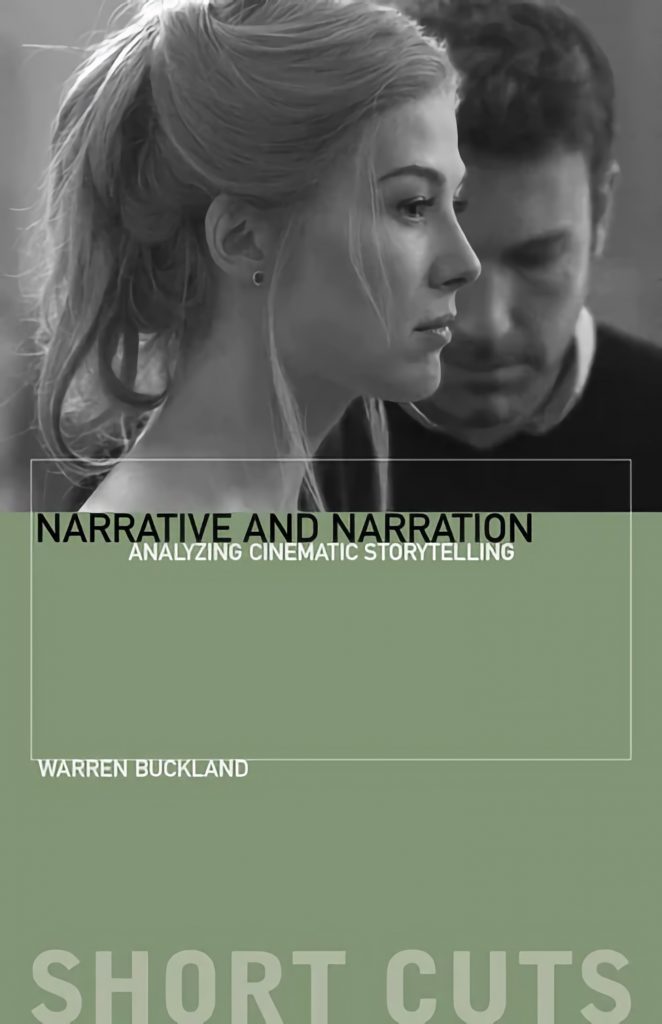
Reviewed by Ruggero Eugeni
The relationship between film theory and semiotics closely resemble the sentimental ones as metaphorically portrayed by Woody Allen in Annie Hall (1977) through a famed joke: “This guy goes to a psychiatrist and says, ‘Doc, my brother’s crazy; he thinks he’s a chicken.’ The doctor says, ‘Well, why don’t you turn him in?’ The guy says, ‘I would, but I need the eggs.’” Film scholars would gladly replace semiotics with less dated approaches such as philosophy, aesthetics, cultural studies, cognitivism, and neurocognitivism. The problem is that, in the end, they need the eggs, especially when dealing with film analysis; hence, the periodic recovery of semiotics in more or less updated versions.
For Warren Buckland, fidelity to semiotics (also applied to contemporary objects such as puzzle movies) is a trademark. His latest volume summarizes and systematizes many classical semiotic approaches in the form of a handbook of film narratology full of examples of analysis and bibliographic references, and that is also accessible to undergraduate students (in accordance with the format of the Columbia UP – Wallflower Short Cuts series). The book is structured around the classic distinction between story and discourse, that is, between “narrative (a linear causal temporal logic), [and] narration (the recounting of narrative events)” (p. 3). In the first part (“The Basics”), Buckland introduces this core of the book’s contents. In the second part (“Types of Storytelling”), he develops two further and connected topics: the relationship between narration and cultural values (in particular those linked to gender identities), and the application of narratological tools to historically determined forms of film storytelling, with a specific focus on contemporary such forms. Each of the two parts contains four chapters, each covering scholarship considered fundamental and reporting on or carrying out several film analyses to exemplify content and methods. Moreover, some further readings are suggested at the end of each chapter.
“The book is an astute synthesis of film narratology, and it is extremely useful for university courses in film semiotics. Nonetheless, it leaves open the problem of a possible or desirable synthesis between the different perspectives of the discipline.”
The first part of the volume opens with a chapter dedicated to “The Emergence of Narrative, Narration, and Narrative Agents in Early Cinema”. It “outlines the transformation of the ‘cinema of attractions’ into the cinema of ‘narrative integration’ using a celebrated example, The Gay Shoe Clerk (Edwin S. Porter, 1903)” (p. 4). It the wake of Tom Gunning and André Gaudreault, Buckland analyzes narrative integration in early cinema on the one hand, as the birth of a new type of “immersive” experience for the spectator, and on the other hand, as the emergence of a new kind of narrator entirely implicated by and within the arrangement of moving images.
The second chapter (“Narrative structure in classical and contemporary Hollywood”) recovers the classic narratology of the Sixties and Seventies derived from Vladimir Propp’s structural model of the Russian folktale. Here, Buckland presents two applications of Propp’s model to cinema: that of Peter Wollen in the analysis of some of Hitchcock’s films; and that of Umberto Eco in his study of Ian Fleming’s novels on James Bond. The author then analyzes the more recent movie Quantum of Solace (Marc Forster, 2008) with the same method.
The third chapter moves to “Narration”, that is to the interpretative steps that a film provides for its viewer thanks to gaps, omissions, and delays in the passage of information. In this case, Buckland juxtaposes Peter Wollen’s classic analysis of North by Northwest (Alfred Hitchock, 1959) with Buckland’s own examination of Gone Girl (David Fincher, 2014). The second part of the chapter shifts from the role of the reader viewer to the role of characters as “filters” of the spectator’s narrative interpretations; drawing on Edward Branigan’s work, Buckland analyzes the Australian film beDevil (Tracey Moffatt, 1993) and a sequence from Jurassic Park (Steven Spielberg, 1993).
The fourth chapter, devoted to “Enunciation and reflexivity”, takes up from Christian Metz the idea that scholars should consider the enunciation, that is the inscription within the film of marks referring to the movie itself (whether as different forms of interpellation addressed to the viewer, or as screens-within-screens). On this basis, Buckland analyzes Grand Budapest Hotel (Wes Anderson, 2014). An essay by Raymond Bellour on Hitchcock’s Marnie (1964) leads Buckland to point out the difference and the relationships between director, author, and enunciator.
The fifth chapter inaugurates the second part of the volume by addressing the topic “Feminism, narrative, authorship”. Here, Buckland focuses on the deconstructions of the patriarchal ideology typical of classical cinema: based on Bellour’s work, he considers the representation of male and female desire and its transformations from Hitchcock’s films to the aforementioned Gone Girl. Moreover, Buckland explores the theoretical and actual definitions of specifically female authorship. To this end, he draws from many feminist works a list of nine features; he then uses this grid to analyze Sally Potter’s Orlando (1992).
Chapter six focuses on narration in the so-called “Art Cinema”; Buckland mainly uses an essay by David Bordwell to isolate four main characteristics of this kind of film storytelling (loosening of cause-effect logic, realism, authorial expressiveness, and ambiguity), whose presence he tracks down in Alice in the Cities (Wim Wenders, 1974) and Inland Empire (David Lynch, 2006).
“The second relevant aspect of Buckland’s book consists of the programmatic exclusion of the sensitive and emotional aspects of the spectator’s experience, and therefore in the rejection of the phenomenological side of film analysis.”
The seventh chapter is devoted to unreliable narration and puzzle movies. In taking up some topics from chapter 3, Buckland shifts the attention from the cognitive to the epistemic value of the spectator’s interpretive activity (from knowing to believing). In particular, the author relies on the detailed analysis of You Only Live Once (Fritz Lang, 1937) by George M. Wilson, and of Stage Fright (Alfred Hitchcock, 1950) by Kristin Thompson. In the second part of the chapter, Buckland turns to his own definition of puzzle movies, that is films combining epistemic uncertainty and narrative complexity; as an example, he analyzes The Butterfly Effect (Eric Bress and J. Mackye Gruber, 2004).
Finally, in the last chapter, Buckland examines films adopting narrative constructions typical of videogames. With a procedure that the reader has now learned to recognize, the author compiles a list of 16 characteristics of videogame narration based on various scholars’ contributions and traces their presence in The Fifth Element (Luc Besson, 1997), Source Code (Duncan Jones, 2011), and Inception (Cristopher Nolan, 2010).
Beyond its undoubted didactic usefulness, Buckland’s volume encourages some considerations on the return of the Screen Theory of the Seventies and Eighties within the current landscape of film studies – on which see Vaughan and Conley (2018) – and in particular on the role of semiotics and narratology in this context. From this point of view, two aspects of Buckland’s book seem relevant.
First, the book indicates that under the same roof of cinema semiotics coexist two paradigms that are not automatically compatible: on the one hand, a structuralist approach that assumes the narrative structures of the text as its objects; on the other, an interpretative approach that studies the viewers and their experiential processes – also using the methods of empirical, cognitive, and neurocognitive sciences. Buckland focuses on the first approach, but cannot avoid referring to the second, especially when he considers narration: on this point, not surprisingly, he cites Bordwell instead of drawing on the more “classic” works by Gérard Genette, Jacques Aumont, or François Jost.
The second relevant aspect of Buckland’s book consists of the programmatic exclusion of the sensitive and emotional aspects of the spectator’s experience, and therefore in the rejection of the phenomenological side of film analysis – even in recent neurocognitive-inspired versions such as those by Smith (2018) or Gallese and Guerra (2020). This exclusion certainly produces a greater theoretical consistency. Yet, it excludes some relevant film analysis areas, such as that of the emotions and feelings designed by movies and lived by spectators.
In conclusion, the book is an astute synthesis of film narratology, and it is extremely useful for university courses in film semiotics. Nonetheless, it leaves open the problem of a possible or desirable synthesis between the different perspectives of the discipline, and therefore the question of a method of film analysis that considers the film as the project of a complex, multidimensional experience for its viewer – an experience that would be at the same time cognitive, epistemic, emotional, sensitive, and perhaps even sensory-motor. But probably, to prepare this dish, we need more eggs than semiotics can provide.
References
Gallese, Vittorio, and Michele Guerra. 2020. The Empathic Screen: Cinema and Neurosciences, Oxford: Oxford University Press.
Smith, Murray. 2017. Film, Art, and the Third Culture: A Naturalized Aesthetics of Film. Oxford: Oxford University Press.
Vaughan, Hunter, and Tom Conley. 2018. The Anthem Handbook of Screen Theory. London: Anthem Press.

